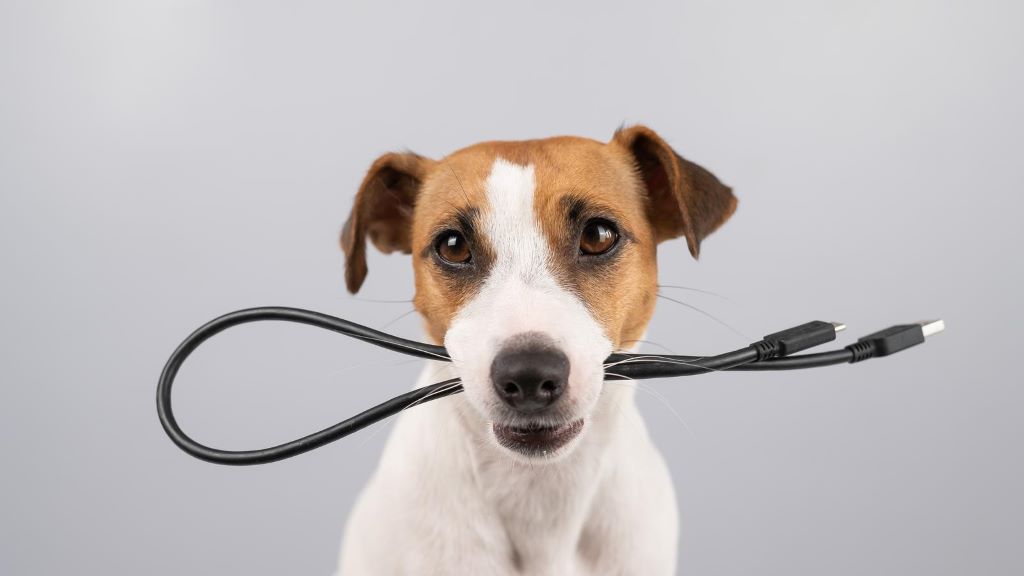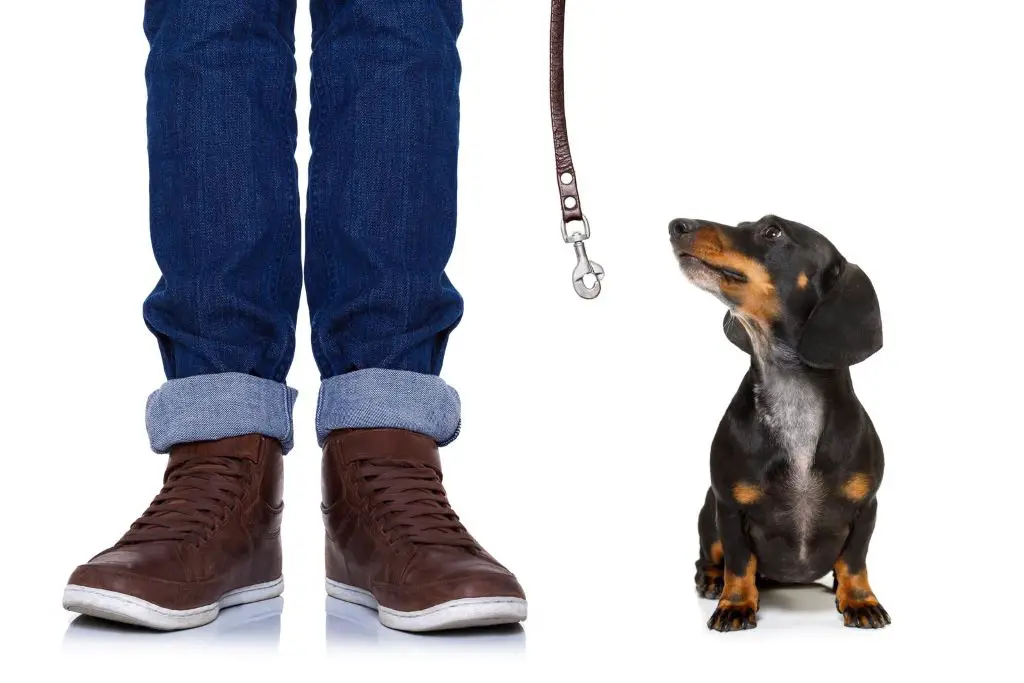Imagine the joy of coming home to find your favorite four-legged friend wagging their tail in excitement, only to discover they’ve been chewing on the metal legs of your dining room table.
You’re baffled, asking yourself, ‘why does my dog chew on metal?’ This isn’t just a perplexing habit; it can also be dangerous for their health.
In this article, we’ll delve into the reasons behind this unusual behavior, known in the veterinary world as Pica. We’ll explore the attraction dogs may have to metal, the potential dangers this poses, and the symptoms and causes of Pica.
Plus, we’ll guide you through treatment options and training techniques to curb this behavior, and suggest some safer, healthier alternatives for your dog’s chewing needs.
So, if you’re struggling to understand your furry friend’s metallic munching, stick around; we’ve got answers for you.
Key Takeaways
• Dogs chewing on metal can be a sign of anxiety or nutritional deficiency.
• Chewing on metal can cause severe damage to a dog’s teeth and digestive system.
• Pica in dogs, which includes chewing on metal, can indicate underlying health issues or dietary deficiencies.
• To reduce chewing on metal, it is important to provide mental stimulation, physical exercise, safe chew toys, and positive reinforcement.
Understanding Canine Chewing
Just like a toddler teething, your pooch’s penchant for chewing on metal isn’t just a quirky pastime; it’s an urge deeply rooted in their canine instincts.
To start understanding canine chewing, you must first realize that chewing behavior is a natural activity for dogs. It helps with their dental health, keeps them entertained, and can even be a stress reliever.
It’s not uncommon for dogs to chew on anything they can get their paws on, including metal objects. But there’s a line between normal chewing behavior and an obsession with chewing on metal.
If your dog chews on metal excessively, it could be a sign of a deeper issue, like anxiety or nutritional deficiency. Observing your dog’s chewing habits is the first step in understanding why they are attracted to metal objects.
Metal Attraction in Dogs
Intriguingly, our four-legged friends often display an unusual attraction to metallic objects. You might have noticed your dog chewing metal objects or trying to lick metal objects around your home. This behavior, known as metal attraction in dogs, can be puzzling and concerning.
Some dogs might be attracted to the cool, hard texture of the metal. However, if your dog is consistently attracted to metal, it could be a sign of an underlying medical issue. Certain deficiencies or conditions might cause your dog to crave non-food items, a condition known as pica. It’s crucial to monitor this behavior and seek veterinary advice if it persists.
Remember, chewing metal can cause severe damage to your dog’s teeth and digestive system.
Potential Dangers
It’s heart-wrenching to consider, but your furry friend’s attraction to shiny, metallic objects could lead to a whole host of dangerous complications. When your dog is licking metal, it’s not just a peculiar behavior—it’s a potential risk.
Metallic objects like a metal crate can cause oral injuries, tooth fractures, and gastrointestinal harm. Chewing non-food items like metal could lead to a condition known as pica, which can be harmful over time.
If you notice metal licking, it’s crucial to curb this habit immediately. Keep a watchful eye on your pooch and remove any accessible metal items.
Lastly, don’t hesitate to take your dog to the vet if you observe persistent metal-chewing behaviors. Early intervention can prevent severe health issues and ensure a happy, healthy life for your dog.
Identifying Pica in Dogs
Spotting signs of pica in your beloved pet isn’t always straightforward and can often be mistaken for simple curiosity or boredom. Pica in dogs is a condition where they have a compulsive urge to eat nonfood items like metal, rocks, or plastic. It’s crucial to know the difference between your pet’s regular chewing behavior and a potential metal obsession.
Identifying pica in dogs requires careful observation. Are they repeatedly consuming nonfood items and not just exploring with their mouths? Are they showing signs of distress or discomfort after ingestion? Dogs with pica may exhibit unusual behavior, such as restlessness or anxiety, especially if they can’t access their preferred nonfood item.
If you suspect pica, it’s essential to consult with a vet immediately for appropriate diagnosis and treatment.
Symptoms and Causes of Pica
While pica might seem like an odd behavioral quirk, it’s often indicative of underlying health issues or dietary deficiencies. Symptoms of pica can range from vomiting and diarrhea to lethargy and unusual behavior. If you notice your dog has a strange attraction to non-food items, like metal, you might be dealing with a case of pica.
The symptoms and causes of pica can vary, but the common reason is usually an unmet dietary need or a lack of mental stimulation. Constant chewing or licking of metallic objects, like coins or jewelry, is a clear sign of this condition.
Pica might also be a result of anxiety or stress, leading to an unusual attraction to metal. It’s crucial to seek a vet’s advice if you observe these behaviors.
Treatment Options for Pica
Curbing your pet’s unusual craving for non-food items can be a bit challenging, but don’t worry; there are plenty of treatment options available for pica.
If your dog is obsessed with chewing everything, especially metal objects, it’s essential to seek professional help. Veterinarians can offer valuable advice and treatments, ranging from dietary changes to medications.
You might also consider behavioral modifications. This could involve providing more physical activity or mental stimulation, such as puzzle toys that are safe for dogs to chew. If your dog is licking metal objects, redirect their attention to more suitable items. Remember, patience is key.
Over time, with consistent effort and the right treatment options for pica, your dog’s bizarre chewing habits can be managed effectively.
Training to Reduce Chewing
Breaking your pup’s habit of gnawing on unsuitable items can be a breeze with the right training techniques!
Here are a couple of dog training strategies that you might find useful:
• Redirect and Distract: Whenever you catch your dog chewing on metal, quickly distract your dog with a noise or a toy. This will break their focus and give you an opportunity to redirect their attention to an appropriate chew toy.
• Keep a variety of chew toys on hand to figure out which ones your dog prefers.
• Regularly rotate the toys to keep your dog interested.
• Positive Reinforcement: Reward your dog when they choose to chew on their toys instead of metal. Training your dog to stop chewing on inappropriate items can be a slow process, but your patience and consistency will pay off.
• Praise and treats can go a long way in reinforcing good behavior.
• Remember, chewing can help your dog relieve stress and stay mentally stimulated. So, providing safe and suitable alternatives is essential.
Alternative Chewing Solutions
Bolstering your buddy’s boredom with brilliant bite-able alternatives can certainly curb their craving for inappropriate chewing targets. Safe chew toys are a fantastic solution to your dog’s destructive chewing habits. These toys are designed to be tough and durable, giving your pup a satisfying chew session without the risk of damaging their teeth or swallowing harmful materials.
Alternative chewing solutions also include edible chew treats and bones. Keep in mind, these should be given in moderation and always under supervision. This is part of essential puppy training to ensure they don’t develop bad chewing habits early on. Remember, dogs chewing on inappropriate items is often a sign of boredom or anxiety. Therefore, adding mental stimulation and physical exercise to their routine can drastically reduce their desire to chew on metal.
Frequently Asked Questions
What are some specific types of metal objects that dogs commonly chew on?
Dogs often chew on various metal objects like coins, jewelry, screws, or nails. They may also be attracted to metal parts of furniture, such as chair legs, or items like keys or soda cans.
Can a dog’s breed influence their tendency to chew on metal?
Yes, a dog’s breed can influence their chewing habits. Some breeds are more prone to chewing due to their high energy levels or strong jaws. However, chewing on metal isn’t typical in any breed.
What are some other unusual items dogs might chew on apart from metal?
Your pooch might think they’re an interior designer, gnawing on your wooden furniture. They could also fancy a career in fashion, chewing your designer shoes. Or maybe a taste-tester, sampling rocks, or plastic toys. Dogs’ tastes can be quite eclectic.
Is there a certain age when dogs are more likely to chew on metal?
Puppies are most likely to chew on metal or other unusual items during their teething stage, around 3-6 months old. However, it’s not restricted to this age. Always monitor your dog’s chewing habits closely.
Are there any home remedies I can try before seeking professional help for my dog’s metal chewing habit?
You’re probably tearing your hair out over your dog’s iron jaw! Try spraying metal objects with bitter apple spray. Provide chew toys or bones to distract them. Ensure they’re getting enough exercise and mental stimulation too.
Conclusion
So, you’re in a bit of a pickle with your pooch’s penchant for metal. It’s not just a quirky habit, but a potential health hazard.
It could be Pica, or just a chew-happy hound. Either way, there’s hope. With the right treatment and training, and alternative chew toys, you can nip this metallic munching in the bud.
Remember, your dog’s well-being is worth every effort. Happy training!











